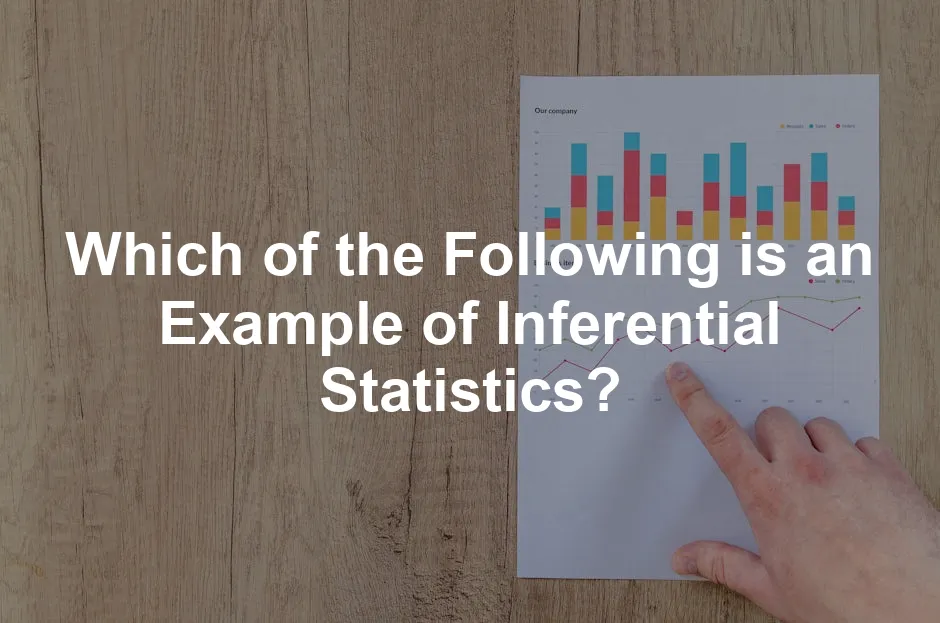Introduction
Statistics can be a wild ride, right? One moment you’re crunching numbers, and the next, you’re making predictions about the future. That’s where inferential statistics comes into play. It’s the superhero of data analysis, swooping in to help us draw conclusions and make educated guesses about a larger group based on a smaller sample.
So, what’s the deal with inferential statistics? At its core, it’s all about making inferences about a population from a sample. Think of it as trying to figure out how many jellybeans are in a jar by counting just a handful. You can’t count them all, but you can get a pretty good idea!
Now, before we dive into the nitty-gritty, let’s clarify the two main branches of statistics: descriptive and inferential. Descriptive statistics are like a summary of your data. They give you the average, the maximum, the minimum, and maybe even a pie chart or two. On the other hand, inferential statistics take it a step further. They allow you to make predictions and test hypotheses about a population—because who doesn’t want to make educated guesses based on limited information?
Understanding inferential statistics is crucial across various fields. Social scientists use it to make sense of survey data, marketers rely on it to forecast trends, and healthcare professionals depend on it for clinical trials. Without it, we’d be flying blind, making decisions based on guesswork rather than sound data.
So, here’s the million-dollar question: “Which of the following is an example of inferential statistics?” Stick around, and we’ll unpack this concept, explore its significance, and maybe even sprinkle in a few jokes along the way!

Key Concepts in Inferential Statistics
Population vs. Sample
In statistics, the terms “population” and “sample” are crucial. The population refers to the entire group we want to study. This could be all the voters in a country, every smartphone user, or even all the jellybeans in a jar. A sample, on the other hand, is a smaller group selected from the population. It’s like taking a handful of jellybeans to guess how many of each color are in the jar. The sample should ideally represent the population to make valid inferences.
Why does this matter? Well, collecting data from an entire population can be impractical or impossible. That’s where samples come in—making it feasible to analyze and draw conclusions without needing to survey everyone.
If you’re looking to dive deeper into the world of statistics, consider checking out Statistics for Dummies. This book breaks down complex concepts into manageable bites, making it perfect for beginners and seasoned statisticians alike!

Parameters and Statistics
Parameters and statistics are two sides of the same coin. A parameter is a value that summarizes a characteristic of a population, like the average height of all adults in a city. Conversely, a statistic summarizes a characteristic of a sample, such as the average height of a group of 100 randomly selected adults from that city.
The critical difference? Parameters are generally unknown and fixed, while statistics are calculated from the sample data and can vary from sample to sample. This distinction is what makes inferential statistics so powerful: using statistics from a sample to estimate the parameters of a larger population.
Sampling Error
Sampling error is a pesky little gremlin that pops up when we use a sample to represent a population. It refers to the difference between the actual population parameter and the statistic derived from the sample. Imagine measuring the average height of a sample of basketball players to infer the average height of all players. If your sample is too short or tall, your estimate will be off.
This error happens even with the best sampling methods. It’s all about probability. The larger and more random your sample, the smaller the sampling error tends to be. Recognizing and minimizing sampling error is vital for making reliable inferences.
If you’re diving into statistics, you might need tools to assist you. Check out statistical analysis software like R. It’s a powerful tool that’s widely used for statistical computing and graphics!

Importance of Inferential Statistics
Inferential statistics is the backbone of informed decision-making in many fields. In healthcare, it helps researchers assess the effectiveness of new treatments. Economists use it to forecast trends and understand consumer behavior, while social scientists analyze survey data to gauge public opinion. For more on this, check out the master of science in applied statistics for social science research.
Without inferential statistics, decision-making would be like trying to navigate without a map. It helps us make predictions about larger groups based on smaller samples, providing insights that guide policy, investment, and healthcare decisions. Essentially, it transforms data into actionable knowledge, making it indispensable across diverse sectors.
Looking to enhance your data visualization skills? Check out data visualization software like Tableau. It’s a fantastic way to represent your data in a more digestible format!

Distinguishing Inferential from Descriptive Statistics
Statistics can be a bit like a buffet. You have your descriptive statistics, which serve up a plate of facts about your data. These are the summaries, the averages, and all that jazz. Picture this: you find the mean height of a sample group of 50 people. That’s just descriptive statistics strutting its stuff! You’re simply stating what you have without making any grand assumptions.
Now, let’s turn the spotlight on inferential statistics. This is where the magic happens! Imagine using that mean height you calculated from your sample of 50 to estimate the average height of a whole population. Voilà! You’re making inferences about the larger group based on your smaller sample. That’s inferential statistics, folks! It’s like saying, “Based on my sample, I’m pretty sure the entire class is taller than a garden gnome.”
To illustrate further, think about these examples:
- Descriptive Statistics: Finding the average height of 50 female students at State University. Here, you’re just summarizing data from that specific group, without any wild predictions.
- Inferential Statistics: Testing the longevity of 100 light bulbs to estimate how long all light bulbs of that brand will last. Now you’re using your sample to draw conclusions about the whole shebang!
Understanding this distinction is crucial. Descriptive statistics gives you the snapshot, while inferential statistics opens the door to making those educated guesses. So the next time you’re knee-deep in data, remember: whether you’re just reporting or predicting, you’re either indulging in a descriptive feast or embarking on an inferential adventure!

Interpreting Results
In the realm of inferential statistics, p-values and confidence intervals are your trusted sidekicks. They help you make decisions based on sample data, giving you a glimpse into the larger population’s secrets.
First up, p-values. Think of a p-value as your statistical lie detector. It tells you the probability of observing your data, or something more extreme, assuming the null hypothesis is true. A low p-value (typically less than 0.05) suggests that your results are statistically significant. In simpler terms, it’s like saying, “Whoa! This result probably didn’t happen by chance!”
Now, let’s chat about confidence intervals. These intervals provide a range of values that likely contain the population parameter. Picture this: you conduct a survey on how much coffee people drink. If your 95% confidence interval for average coffee consumption is between 2 and 4 cups, you can be pretty sure that the true average lies somewhere in that range. It’s a way to quantify uncertainty, giving you a better feel for your estimates.
Together, p-values and confidence intervals act like a dynamic duo, guiding you through the murky waters of data interpretation. They help ensure that decisions based on statistical analyses are informed and reliable.

Confusion Points and Common Misunderstandings
Misconceptions about Inferential Statistics
Many folks get tangled up in the web of statistics, confusing descriptive statistics with inferential. Descriptive statistics summarize data from a sample, providing insights like averages or percentages. Imagine you’re at a party counting how many people prefer pizza over tacos. That’s descriptive! You’re simply reporting what’s happening in your little world.
Inferential statistics, however, requires a leap of faith. It takes a sample and makes predictions about a larger population. Using our party example, if you asked a handful of guests about their food preferences and then inferred that the same trends hold for all your friends, that’s inferential statistics in action. You’re making educated guesses based on limited information.

Real-Life Applications and Examples
Let’s look at some real-life scenarios where inferential statistics went awry, leading to rather amusing and misleading conclusions. Imagine a marketing team conducting a survey about a new snack product. They only ask their colleagues—snack enthusiasts, of course. The results show overwhelming support for the product. But surprise! When they launch it to the general public, it flops. Lesson learned: sample bias can lead to devastatingly incorrect predictions.
In healthcare, researchers sometimes face similar pitfalls. Take a clinical trial testing a new medication. If the trial only includes young, healthy participants, the results may not apply to older adults or those with chronic conditions. This could lead to misleading conclusions about the drug’s effectiveness for the general population.
These examples highlight the importance of proper sampling techniques in inferential statistics. When missteps occur, decisions based on these analyses can lead to misguided strategies and even financial losses. Always ensure your samples represent the population to avoid these pitfalls!

Conclusion
In summary, inferential statistics is a powerful tool for making predictions and drawing conclusions from sample data. We’ve explored how p-values and confidence intervals guide us through data interpretation. We also tackled common misconceptions, emphasizing that proper sampling is crucial for valid inferences.
Understanding these concepts helps you navigate the statistical landscape more confidently. Whether in marketing, healthcare, or everyday decision-making, applying inferential statistics appropriately can lead to better outcomes. So next time you find yourself knee-deep in data, remember the importance of using reliable sampling methods and interpreting results wisely. Happy analyzing!

Final Thoughts
Understanding inferential statistics is not just for the mathematically inclined. It’s a key ingredient in the recipe for making informed decisions based on data analysis. Think of it as your trusty compass, guiding you through the vast sea of numbers and helping you navigate towards meaningful conclusions. Whether you’re in marketing, healthcare, or social research, inferential statistics equips you with the power to make predictions about entire populations based on a mere sample. It’s like trying to guess the flavor of a whole ice cream tub after tasting just one scoop—deliciously informative!
The world is full of uncertainties, and inferential statistics helps us tame those uncertainties. It enables us to assess hypotheses, estimate population parameters, and even draw conclusions that can impact policies and business strategies. So, the next time you find yourself wrestling with data, remember that inferential statistics is your ally in making sense of it all.

FAQs
What is the difference between descriptive and inferential statistics?
Descriptive statistics summarize data effectively. For example, if you collect the heights of 50 students and calculate the average height, that’s descriptive. You’re simply reporting what you’ve observed. On the flip side, inferential statistics lets you take that average height and use it to make predictions about the entire student population. It’s like saying, “Based on my sample, I think the average height of all students is around X.” Descriptive statistics gives you a snapshot; inferential statistics opens the door to predictions and broader insights.
Can inferential statistics be applied to any type of data?
Not quite! Inferential statistics works best with data that is randomly sampled and representative of a larger population. This means your sample needs to reflect the population’s characteristics. For instance, if you’re studying voting behavior, you want to survey a diverse group of voters, not just your circle of friends. Proper sampling ensures your inferences are valid and reliable.
Why is sampling important in inferential statistics?
Sampling is crucial because it directly impacts the validity of your conclusions. A well-chosen sample can provide insights into the larger population, while a poor sample can lead to misleading results. Think of it like choosing a few apples from a basket to determine the overall quality. If you only pick the shiny ones, your conclusions may not represent the basket as a whole. Good sampling techniques help minimize sampling error and enhance the reliability of your inferences.
How can I improve my understanding of inferential statistics?
Ready to level up your stats game? Consider enrolling in online courses on platforms like Coursera or edX. Books like “Statistics for Dummies” can provide a friendly introduction. Websites like Khan Academy offer free resources to help you grasp the concepts. And don’t forget about YouTube tutorials! Engaging with practical examples and case studies can also deepen your understanding. The key is to practice, ask questions, and explore various resources until you feel confident navigating the world of inferential statistics!
And if you’re looking for a fun way to take a break from all this number crunching, consider picking up a board game for social gatherings. It’s a great way to unwind and still keep those cognitive skills sharp!
Please let us know what you think about our content by leaving a comment down below!
Thank you for reading till here 🙂
All images from Pexels




